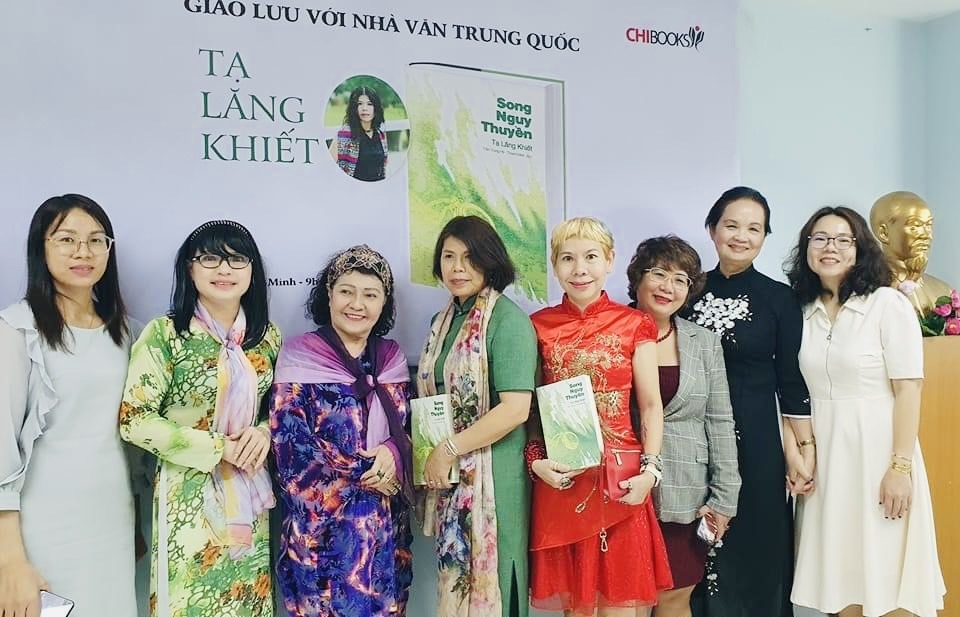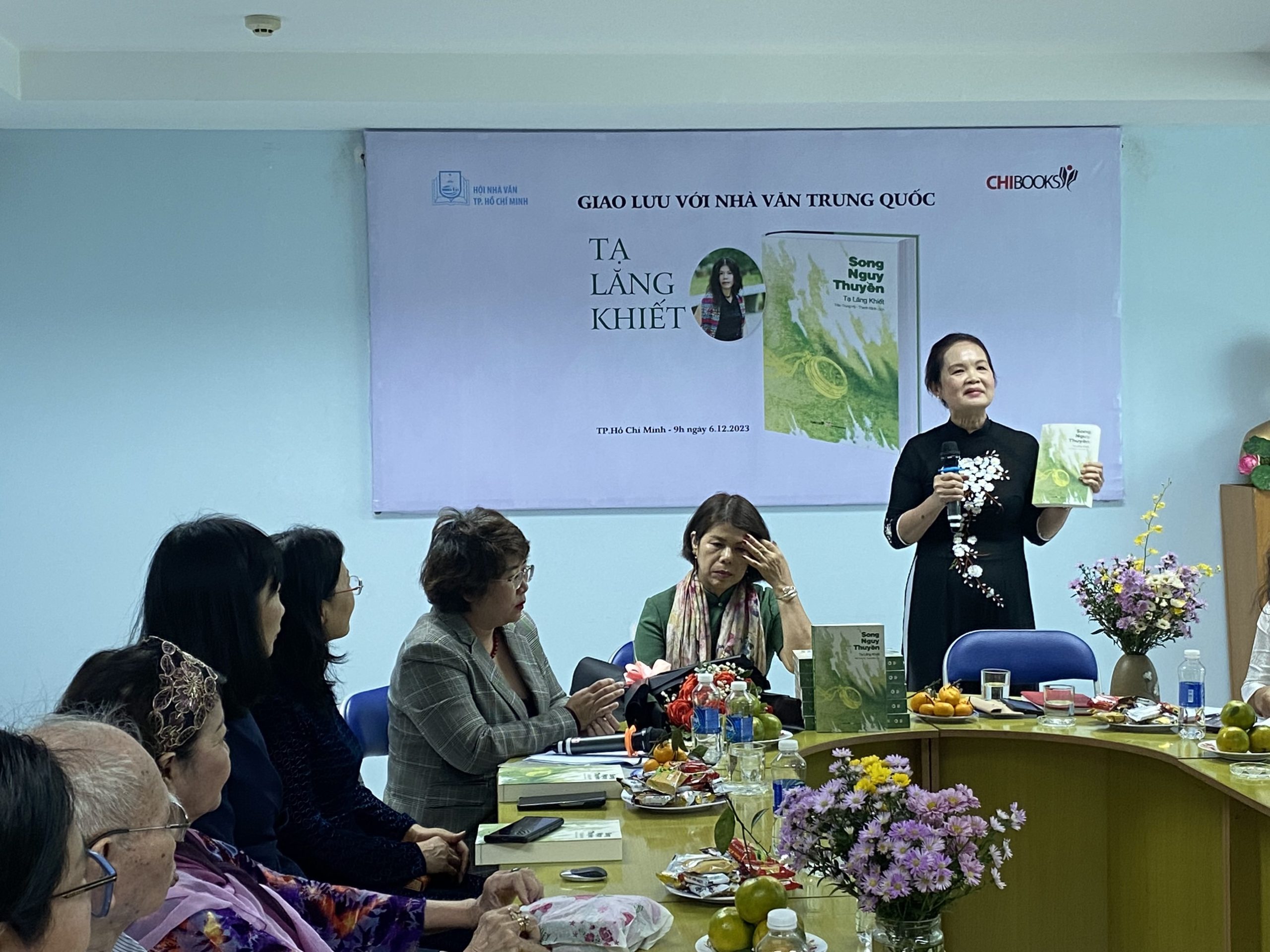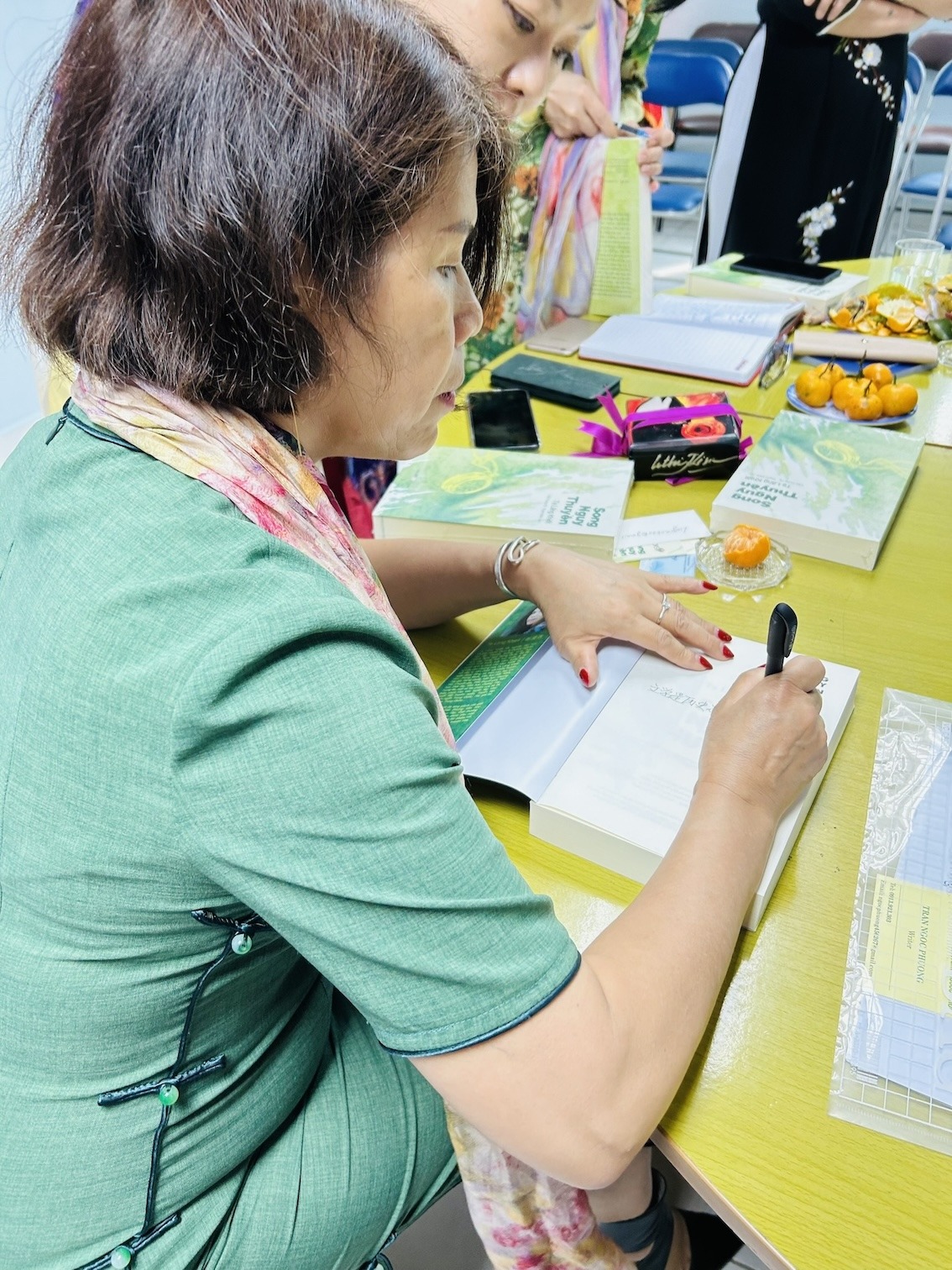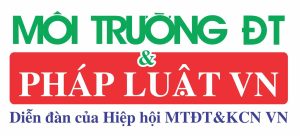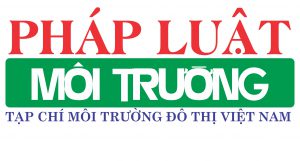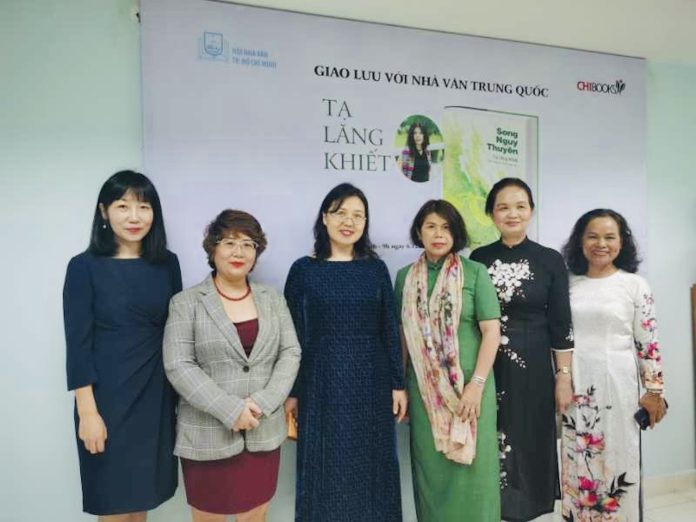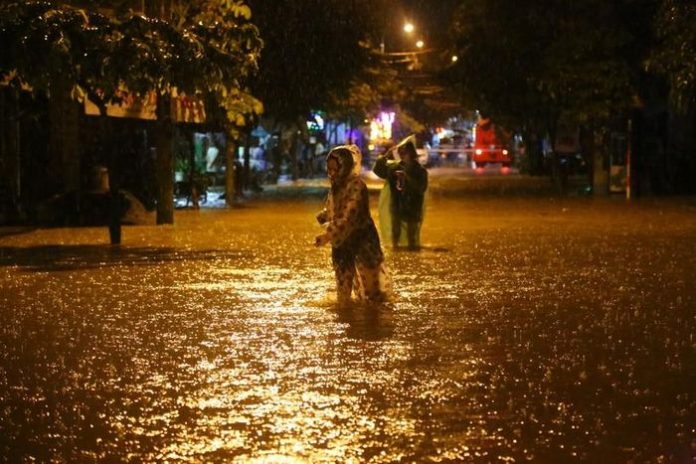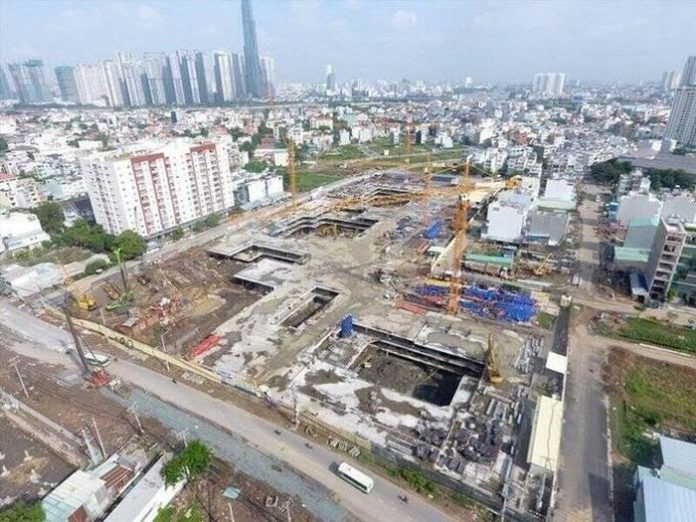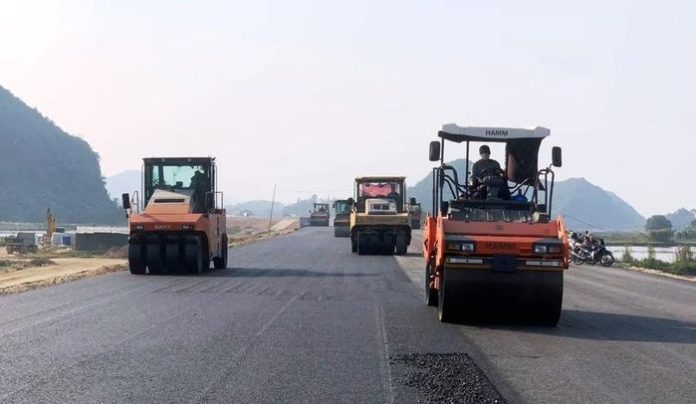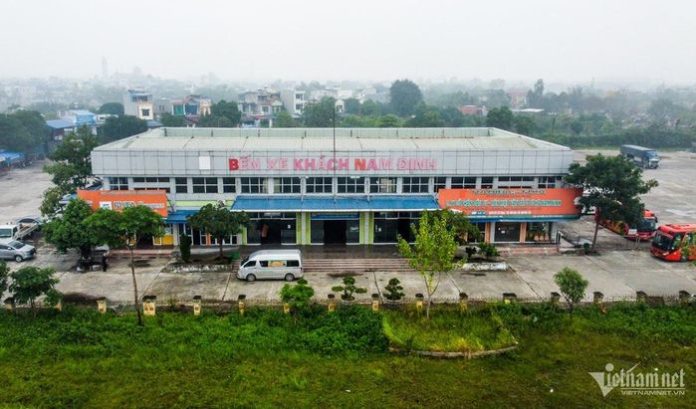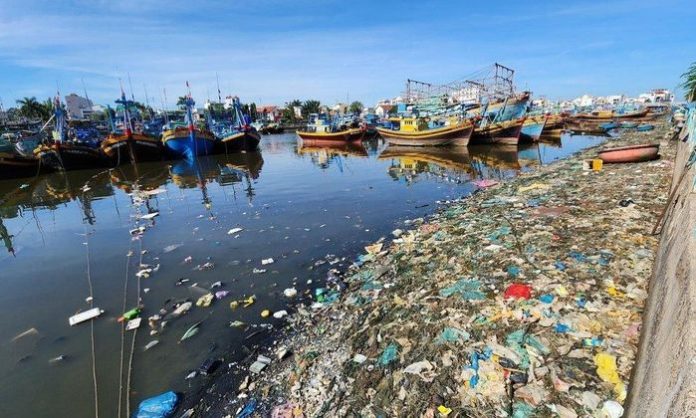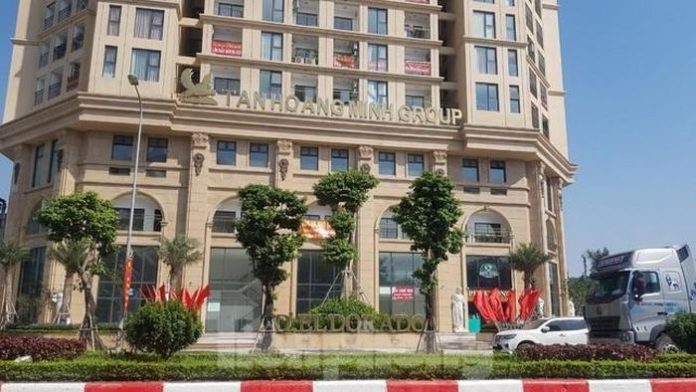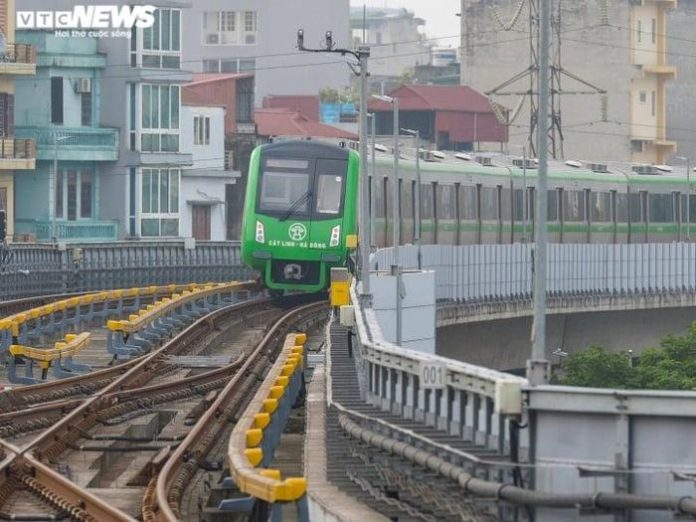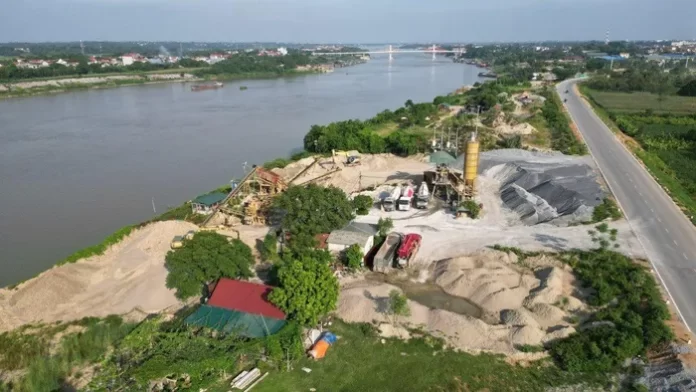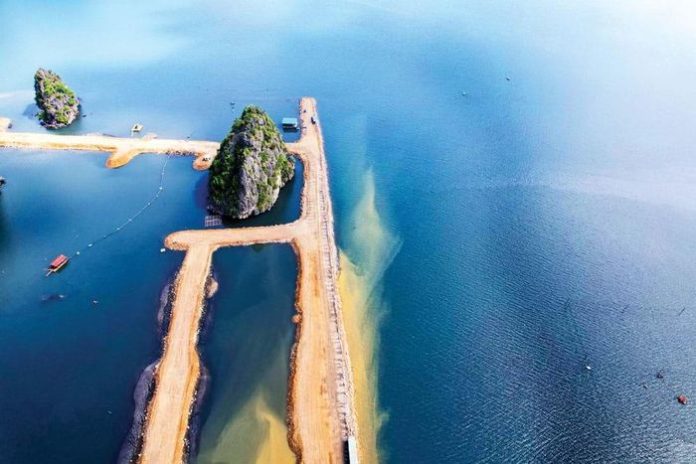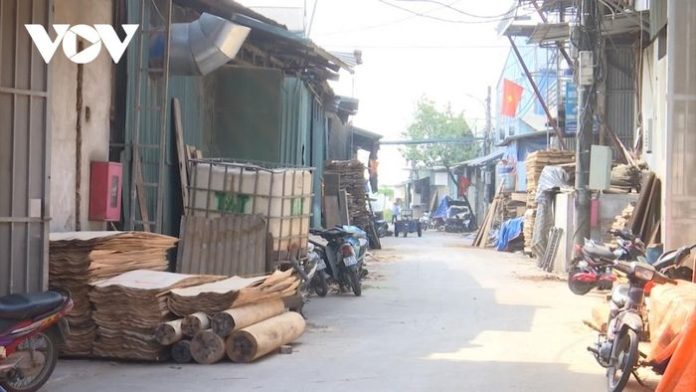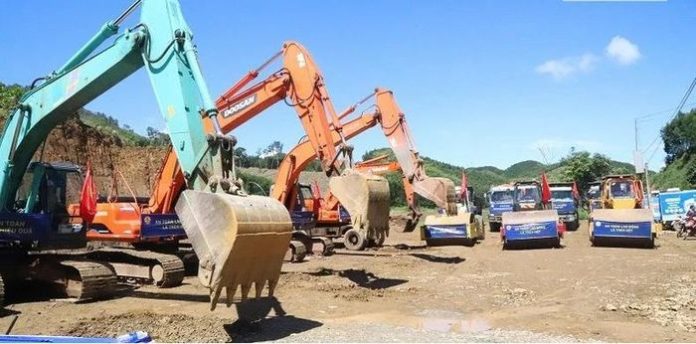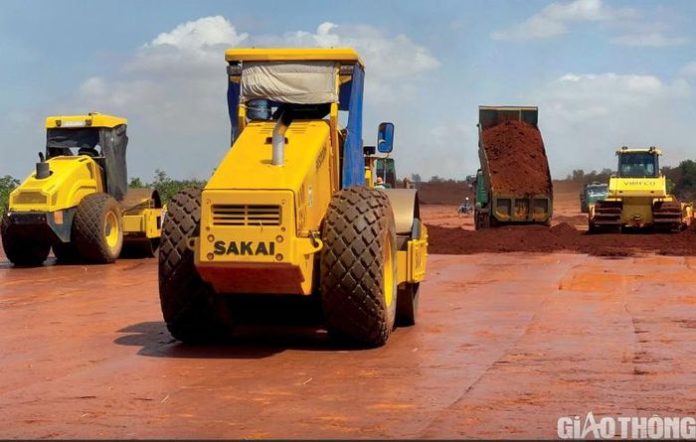Trân trọng giới thiệu tới quý độc giả Công bố quốc tế lĩnh vực môi trường số 45-2023.
Về quản lý môi trường
– Việc phân loại khay PET có ảnh hưởng đến tính bền vững của rác thải nhựa không? Phương pháp LCA và cách tiếp cận chi phí-doanh thu.
– Khám phá mối tương tác giữa khí hậu, khả năng miễn dịch dân số và động lực lây truyền SARS-CoV-2 ở các nước Địa Trung Hải.
– Giảm thiểu đáng kể mức độ ô nhiễm PM2.5 thông qua việc giảm phát thải NOx trong mùa đông.
– Chính sách thuế môi trường dài hạn và ngắn hạn trong bối cảnh thông tin bất cân xứng.
– Dự đoán được hỗ trợ bằng máy học và mô hình động học được tối ưu hóa của quá trình phân hủy clo dư để tăng cường quản lý chất lượng nước.
– Theo dõi ô nhiễm PFAS chưa xác định – Xét nghiệm TOP trực tiếp trong giám sát không gian nước mặt ở Đức.
– Đánh giá hàm lượng carbonyl trong khí quyển trong môi trường đô thị của Argentina.
– Tổng hợp khí thải xe cộ theo cấp vùng và cấp bang ở Ấn Độ và cách giảm thiểu chúng do các tiêu chuẩn khí thải xe cộ.
– Hướng tới bảo tồn năng lượng bằng cách xây dựng thêm cơ sở hạ tầng giao thông?: Khung phân tích biên giới ngẫu nhiên nội sinh.
Về môi trường đô thị
– Dự báo tác động của việc phát sinh và phân phối chất thải nhựa rắn đô thị bằng cách sử dụng động lực hệ thống: Một nghiên cứu điển hình ở Dubai.
– Ảnh hưởng của nước rỉ rác từ bãi rác đến bề mặt và nước ngầm và những rủi ro sức khỏe cộng đồng có thể xảy ra.
– Ảnh hưởng của sự khác biệt về quy mô đô thị đến việc ước tính cường độ đảo nhiệt đô thị bề mặt: Đánh giá quy mô toàn cầu tại 892 thành phố.
– Hỗ trợ các đô thị phát triển khả năng cộng tác nhằm tạo điều kiện thuận lợi cho quá trình chuyển đổi đô thị và tính bền vững: Vai trò của các trung gian chuyển đổi ở Madrid Ứng dụng công nghệ giải trình tự thông lượng cao và các công cụ phân tích để phát hiện mầm bệnh trong hệ thống nước đô thị: Tiến bộ và triển vọng trong tương lai.
– Ảnh hưởng của đô thị hóa đến nồng độ PM2.5: Đánh giá hệ thống và phân tích tổng hợp.
– Hiệu suất vận hành của phần hữu cơ trong chất thải rắn đô thị được thải ra khỏi cộng đồng, sử dụng công nghệ ủ phân hữu cơ trong thùng chứa.
– Đánh giá trong 40 năm qua về sự khác biệt giữa thành thị và nông thôn về ô nhiễm Benzo[a]pyrene và nguy cơ sức khỏe con người ở vùng duyên hải Trung Quốc.
– Đánh giá giám sát nhanh nước thải để xác định sự lây lan của bệnh truyền nhiễm tại các đô thị.
Về môi trường khu công nghiệp
– Khám phá mối quan hệ giữa tỷ lệ ô nhiễm kim loại (loid), điều kiện hóa lý và động lực của cộng đồng vi sinh vật trong đất đô thị bị ô nhiễm công nghiệp.
– Con đường hướng tới hiệu quả môi trường: Mối liên hệ giữa quản lý nguồn nhân lực xanh, đổi mới xanh và hành vi xanh tại nơi làm việc ở các công ty sản xuất.
– Đánh giá chính sách về sự cân bằng kinh tế – môi trường trong việc điều tiết sử dụng nước công nghiệp: Mô hình dựa trên tác nhân.
– Loại bỏ các chất ô nhiễm hữu cơ khỏi muối thải công nghiệp bằng phương pháp nhiệt phân và tiềm năng sử dụng để lưu trữ năng lượng.
– Chiến lược carbon thấp, hoạt động kinh doanh và thay đổi cơ cấu công nghiệp: Bằng chứng từ một thí nghiệm gần như tự nhiên.
– Thu hồi và tận dụng dịch lọc thải từ quá trình lên men sinh học công nghiệp: Đặc điểm phát triển và chuyển hóa của phân bón sinh học dạng lỏng Bacillus cereus.
– Cách tiếp cận kiểm soát đất đai của chính phủ, sự tích tụ công nghiệp và chất lượng không khí đô thị: Phân tích dựa trên sự lan tỏa không gian và các hiệu ứng ngưỡng.
– Phân hủy sinh học và bình ổn hóa chất thải lông vũ bằng cách sử dụng vi khuẩn sản xuất keratinase và ứng dụng của chúng trong các quy trình công nghiệp nguy hiểm với môi trường.
– Cơ sở hạ tầng kỹ thuật số ảnh hưởng đến hiệu quả sinh thái công nghiệp như thế nào? Xem xét tác động ngưỡng của đổi mới hợp tác khu vực.
CHUYÊN TRANG QUẢN LÝ MÔI TRƯỜNG
Tạp chí Môi trường và Đô thị Việt Nam
Trân trọng giới thiệu
ENVIRONMENTAL MANAGEMENT / QUẢN LÝ MÔI TRƯỜNG
1. Does PET trays sorting affect the sustainability of plastic waste? An LCA and cost-revenue approach
Science of The Total Environment, Volume 897, 1 November 2023, 165222
Abstract
Currently, the management of polyethylene terephthalate (PET) trays waste is still challenging since this packaging affects the consolidate recycling of PET bottles. It is important to separate PET trays from the PET bottle waste stream to avoid its contamination during recycling process and to recover a higher amount of PET.
Hence, the present study aims to evaluate the environmental (by means of Life Cycle Assessment, LCA) and economic sustainability of sorting PET trays from the plastic waste streams selected by a Material Recovery Facility (MRF). For this scope, the case of a MRF in Molfetta (Southern Italy) was chosen as reference, and different scenarios have been evaluated by assuming different schemes of manual and/or automated PET trays sorting. The alternative scenarios did not achieve very pronounced environmental benefits over the reference case.
Upgraded scenarios resulted in overall environmental impacts approx. 10 % lower as compared to the current scenario, with the exception of the climate and ozone depletion categories where differences in impacts were much higher. From an economic point of view, the upgraded scenarios achieved slightly lower costs (<2 %) than the current one. Electricity or labour costs were necessary in upgraded scenarios, but in this way fines for PET trays contamination in PET streams for recycling were avoided. Implementing any of the technology upgrade scenarios is then environmentally and economically viable, when the PET sorting scheme is performed in appropriate output streams through optical sorting.
2. The impact of green finance policy on total factor productivity: Based on quasi-natural experiment evidence from China
Journal of Cleaner Production, Volume 425, 1 November 2023, 138873
Abstract
Treating the implementation of green finance policy as a quasi-natural experiment, we explore its effect on the total factor productivity of firms, then perform several tests to illustrate the stability of this effect, and then explain this effect based on financing constraint and technological innovation. It has been found that the green finance policy has an inhibitory effect on total factor productivity, which is validated in various tests including the parallel trend test, the heterogeneity treatment effect test, and the robustness test including the placebo test and endogeneity test.
The heterogeneity analysis shows that different ownership types and industry type of firms have different impacts on this effect. Further extended analysis reveals that the policy leads to the flow of financial resources from polluting firms to non-polluting firms. There is no significant improvement in technological innovation in non-polluting firms, while there is a significant decline in technological innovation in polluting firms due to lack of credit support. Finally, we make several recommendations based on our findings to achieve precise implementation of the green finance policy.
3. Exploring the interplay between climate, population immunity and SARS-CoV-2 transmission dynamics in Mediterranean countries
Science of The Total Environment, Volume 897, 1 November 2023, 165487
Abstract
The relationship between SARS-CoV-2 transmission and environmental factors has been analyzed in numerous studies since the outbreak of the pandemic, resulting in heterogeneous results and conclusions. This may be due to differences in methodology, considered variables, confounding factors, studied periods and/or lack of adequate data. Furthermore, previous works have reported that the lack of population immunity is the fundamental driver in transmission dynamics and can mask the potential impact of environmental variables.
In this study, we aimed to investigate the association between climate variables and COVID-19 transmission considering the influence of population immunity. We analyzed two different periods characterized by the absence of vaccination (low population immunity) and a high degree of vaccination (high level of population immunity), respectively. Although this study has some limitations, such us the restriction to a specific climatic zone and the omission of other environmental factors, our results indicate that transmission of SARS-CoV-2 may increase independently of temperature and specific humidity in periods with low levels of population immunity while a negative association is found under conditions with higher levels of population immunity in the analyzed regions.
4. Coordinating energy and material efficiency strategies for decarbonizing China’s iron and steel sector
Journal of Cleaner Production, Volume 425, 1 November 2023, 139038
Abstract
Achieving carbon neutrality in China critically depends on the successful decarbonization of its iron and steel sector. While previous studies have primarily focused on improving technology performance in steel production processes, the potential CO2 reduction through material efficiency strategies for steel demand management remains largely unexplored.
To bridge this research gap, this study aims to quantitively assess the co-benefits of CO2 reduction from implementing energy and material efficiency strategies along China’s steel flow chain. By integrating dynamic steel flow analysis with a CO2 accounting model, this model traces energy use, material flows, and CO2 emissions along the steel flow chain, then evaluates the CO2 reduction potential of implementing various mitigation strategies by 2060, and finally quantifies the relative contribution of each strategy.
The findings indicate that the coordination of energy and material efficiency strategies can reduce CO2 by more than 80% from the business-as-usual level by 2060. In particularly, the strategies of more recycling, longer lifetimes, and energy efficiency improvements are projected to contribute −68%, −43%, and −11% of CO2 reduction, respectively, even amidst an expected +29% rise of CO2 emissions driven by economic growth. The study can provide more promising options for decarbonizing China’s iron and steel sector and lays the foundation for future analyses that seek to integrate demand-side material efficiency strategies in China’s steel decarbonization modeling.
5. Significantly mitigating PM2.5 pollution level via reduction of NOx emission during wintertime
Science of The Total Environment, Volume 898, 10 November 2023, 165350
Abstract
Despite considerable decreases in fine particulate matter (PM2.5) in Chinese megacities over the past decade, many second- and third-tier cities that distribute abundant industrial enterprises are still facing great challenges for PM2.5 further reduction under the recent policy background of eliminating heavily-polluted weather. In view of core effects of NOx on PM2.5, the deeper reductions of NOx in these cities are expected to break the plateau of PM2.5 decline, however, the link between NOx emission and PM2.5 mass loading is currently lacking.
Herein, we progressively construct an evaluation system for PM2.5 productions based on daily NOx emissions in a typical industrial city (Jiyuan), considering a sequence of nested parameters involving evolutions of NO2 into nitric acid and then nitrate, and contributions of nitrate to PM2.5. The evaluation system was subsequently validated to better reproduce real increasing processes for PM2.5 pollution based on 19 pollution cases, with root mean square errors of 19.2 ± 16.4 %, suggesting the feasibility of developing NOx emission indicators linked to goals of mitigating atmospheric PM2.5.
Additionally, further comparative results reveal that currently high NOx emissions in this industrial city severely hinder the achievement of atmospheric PM2.5 environmental capacity targets, especially in the scenarios of high initial PM2.5 level, low planetary boundary layer height and long pollution duration. It is anticipated that these methodologies and findings would supply guidelines for further regional PM2.5 mitigation, in which source-oriented NOx indicators could also provide some orientations for industrial cleaner production such as denitrification and low nitrogen combustion.
6. Long-term versus short-term environmental tax policy under asymmetric information
Journal of Cleaner Production, Volume 427, 15 November 2023, 139078
Abstract
We examine the interaction between a firm that uses either a dirty or a clean technology to produce a product over two periods, 1 and 2, and an environmentally conscious regulator that chooses the environmental tax/subsidy policy. The regulator ignores with which technology the firm manufactures the product and only has a prior belief about it. In this context, if the regulator can credibly commit to the policy for both periods, social welfare is generally higher than if it cannot commit, because distortions in firm’s production at period 1 for signalling purposes strongly reduces the optimality of an environmental policy of short duration.
A period-by-period policy in which the regulator does not commit to the policy terms for period 2 (which will be contingent to information provided by the firm in period 1) is only optimal when clean technology is very expensive to produce with it and the regulator’s environmental concern is not very high. The results highlight the importance of taking into account the time horizon in policymaking, as well as the limitations of regulatory policies that seek to elicit information about the type of technology used by firms.
7. Large but overlooked carbon differentiations inside China’s provinces matters to mitigation strategies design: Evidence from county-level analysis
Science of The Total Environment, Volume 898, 10 November 2023, 165551
Abstract
In China, wide variations exist not only among different provinces, but also inside provinces. Therefore, intensive policy adjustments are essential for promoting carbon neutral in China, which calls for a clear understanding of carbon emission disparities in each individual province. Based on panel data of 2001 county-level administrative areas from 2004 to 2017, we use Theil index and spatial regression models to measure contributions and distributions of intra-provincial carbon inequality, as well as effects of intra-provincial economic inequality on intra-provincial carbon inequality, in order to design provincial specific strategies considering carbon differentiations inside each province. Our main contributions are studying China’s carbon inequality from intra- instead of inter-provincial perspectives and exploring spatial connections of carbon inequality, which has not been fully discussed in previous studies.
The empirical results indicate that intra- rather than inter- provincial carbon inequality contributes the majority of China’s overall carbon inequality. Intra-provincial inequality shows high levels of regional clustering and decrease from west to east, although their differences are smaller in 2017 than 2004, mainly because carbon inequality levels experience large declines in some central and western provinces. Low carbon inequality levels in eastern provinces are mainly attributed to very negative correlation between development levels and carbon intensity. Intra-provincial economic development inequality plays nonnegligible roles in intra-provincial carbon inequality in all provinces, although they are not the major driving factors in some provinces.
There also exist positive spatial spillover effects of intra-provincial economic inequality on intra-provincial carbon inequality. We provide specific policy suggestions on key areas of carbon emission reductions and demand degree of economic transitions for each individual province and also evaluate effects of “common prosperity” measures, which have been frequently discussed recently, on intra-provincial carbon distributions.
8. Machine-learning-assisted prediction and optimized kinetic modelling of residual chlorine decay for enhanced water quality management
Chemosphere, Volume 341, November 2023, 140011
Abstract
The quality of water changes from source to tap, presenting challenges in maintaining consistent water quality across the system. Predicting water quality in distribution systems, including disinfectant residual loss and by-product formation, has been the subject of research since the early 1990s. Although numerous models have been proposed to predict residual chlorine decay, disputes exist among researchers and experts over the superiority of certain models. Accordingly, this study modified the existing process-based bulk decay models by replacing the initial Total Residual Chlorine (TRC) concentration parameter with TRC demand, leading to an improvement in the models’ performance.
The modification resulted in a 38.03%, 28.02%, 23.11%, and 33.29% average improvement in Mean Squared Error (MSE) values for the First Order Model (FOM), Parallel First Order Model (PFOM), Second Order Model (SOM), and Parallel Second Order Model (PSOM), respectively. The study also introduced an online predictive method based on a Machine Learning (ML) algorithm that predicts the first-order TRC bulk decay rate by using water quality parameters as inputs.
A Gaussian Process Regression (GPR) model was used to predict the kinetic parameters in FOM, which accurately predicted the test sets for most of the cases. In addition, a new methodology was proposed in this study for predicting TRC in water distribution systems that incorporates the variability of source natural organic matter, operational actions, and water demands. This method seeks to develop high-fidelity and robust water quality predictions that provide operational decision support for optimized distribution system management.
In conclusion, this study emphasizes the importance of understanding water quality changes from source to tap and the challenges of maintaining consistent water quality across the system. The study suggests modifying existing models and introducing a novel methodology for predicting residual chlorine in water distribution systems that can improve water quality management and, ultimately, better public health outcomes.
9. Tracking down unknown PFAS pollution – The direct TOP assay in spatial monitoring of surface waters in Germany
Science of The Total Environment, Volume 898, 10 November 2023, 165425
Abstract
PFAS contamination of surface waters in central Europe was investigated in a spatial monitoring using suspended particulate matter and sediment samples. The samples were collected in 2021 at 171 sampling sites in Germany and at five sites in Dutch waters. All samples were analyzed for 41 different PFAS by target analysis to establish a baseline for these compounds. In addition, a sum parameter approach (direct Total Oxidizable Precursor (dTOP) assay) was used to investigate the PFAS load in the samples more comprehensively.
PFAS pollution varied widely between water bodies. Target analysis detected ∑PFAS concentrations between <0.5 and 53.1 μg kg−1 dry weight (dw), while levels of <1.0–337 μg kg−1 dw were determined by dTOP assay. Associations were observed for ∑PFSAdTOP and the percentage of urban area in the vicinity of the sampling sites and, less strongly, for distances to industrial sites (i.e. galvanic/paper) and airports. PFAS hotspots were identified by setting the 90th percentile of the data sets for ∑PFAStarget or ∑PFASdTOP as a threshold. Of the 17 hotspots identified by target analysis or dTOP assay, respectively, there were only six overlaps. Thus, 11 highly contaminated sites could not be identified by classical target analysis.
The results demonstrate that target analysis captures only a fraction of the actual PFAS load, while unknown precursors remain undetected. Consequently, if only the results of target analysis are considered in assessments, there is a risk that sites heavily polluted with precursors will not be identified delaying mitigation actions and risking prolonged negative impacts on human health and ecosystems. Moreover, effective PFAS management requires establishing a baseline for PFAS using target and sum parameters such as the dTOP assay, and then monitoring this baseline on a regular basis to support emission control and to inform risk management of its effectiveness.
10. Assessment of atmospheric levels of carbonyls in an urban environment of Argentina
Chemosphere, Volume 342, November 2023, 140168
Abstract
It is well-documented that carbonyl compounds have adverse effects on human health. On the other hand, these oxygenated volatile organic compounds (OVOCs) are precursors of secondary pollutants such as tropospheric ozone or peroxy acetyl nitrate (PAN). In particular, formaldehyde, the simplest carbonyl, is the most abundant carbonyl in the air generated from the degradation of most volatile organic compounds (VOCs).
This work presents for the first time the characterization and determination of levels of carbonyl compounds by passive monitoring performed from April–December 2021 in the city of Córdoba, Argentina, the second most populated Mediterranean city located in the center of the country. Annual concentrations, considering the 11 carbonyls measured, were in the range of 0.13–8.75 μgm−3. Formaldehyde and acetaldehyde were the carbonyls detected in the highest annual average concentrations of 4.44 ± 1.75 μgm−3 and 3.85 ± 1.44 μgm−3, respectively.
These carbonyls represent a contribution of around 40–57% on total carbonyls measured. Statistical analysis to determine significant differences and Pearson correlations with the meteorological parameters were performed. Spring and summer were found to be the seasons with the highest carbonyl concentration linked to forest fire episodes, especially in springtime. The values for the C1/C2 and C2/C3 ratios showed that sources of carbonyl formation are anthropogenic. In addition, the prop-Equiv concentration was determined, where formaldehyde and acetaldehyde were the main producers of tropospheric ozone. The ozone formation potential (OFP) showed that spring and summer are the seasons where carbonyls contribute to the formation of tropospheric ozone.This study represents a first approach of the carbonyl concentration in the city and of the influence of meteorological parameters on the behavior of carbonyls.
11. Region-wise and state-wise synthesis of vehicular emissions in India and their mitigation due to vehicular emissions standards
Science of The Total Environment, Volume 900, 20 November 2023, 165838
Abstract
The implementation of different stages of Bharat Stage Emission standards (BSES) in India for reducing the vehicular emissions has been in different parts of the country at various points of time. A quantitative assessment of the emission standards in mitigating vehicular emissions at different Indian states will provide an estimate of achievable emissions standards for future norms. In this regard, the present work reports an assessment of the BS standards – BS-III, BS-IV and BS-VI in reducing the exhaust emissions in each of the Indian states.
The assessment is performed through the survival fraction of the vehicles registered with different norms in the two age groups 2013–2017 and 2018–2022 and the corresponding emissions of NOx, CO, VOC, PM2.5 and BC. Over the years 2013–2022, the NOx emissions are the major contributors of vehicular emissions in all the states studied. Surprisingly, the BS-IV vehicles contributed significantly to vehicular emissions in particular states when compared to the BS-III vehicles.
This urged to analyse the impact of meteorological and topographical factors on the vehicular emissions. The results revealed that the vehicular emissions are largely dependent on the temperature and altitude and with an increase in temperature and at high altitudes, the CO and VOC emissions are predominant, even in regions with low vehicle population. This finding therefore indicates that the emission limits are not the same for all over the country and meteorology dependent emission limit should be included in framing the vehicle emission norms.
12. Towards energy conservation by constructing more transportation infrastructure?: An endogenous stochastic frontier analysis framework
Journal of Environmental Management, Volume 346, 15 November 2023, 118992
Abstract
Whether constructing more transportation infrastructure can be helpful for the achievement of energy conservation is a long-running and debatable issue. To answer this question, the relationship between transportation infrastructure and energy efficiency must first be clarified. Nonetheless, the existence of the endogeneity problem poses a challenge to defining the relationship. In this paper, an endogenous stochastic frontier analysis method is used to investigate the influence of transportation infrastructure on energy efficiency. Based on the prefecture-city level panel data in China, we find that after addressing the endogeneity problem, the impact of transportation infrastructure on energy efficiency increases dramatically.
Moreover, this impact is more pronounced in small-scale cities compared to large and medium-scale cities. Regardless of the measurement of transportation infrastructure, instrumental variable, or production function form, we get the similar conclusions, demonstrating the robustness of our findings. Additional simulation analysis shows that the energy conservation potential would be 1222–2935 million kilowatt hours if the level of transportation infrastructure could be optimized. We recommend accelerating the transportation infrastructure construction, particularly in the small-scale cities so as to boost the energy efficiency and achieve energy conservation targets.
13. Influence of the socio-spatial context on the perception of environmental problems in cities in Spain and Argentina
Journal of Cleaner Production, Volume 425, 1 November 2023, 138882
Abstract
Frequently, the relationship between humans and the rest of the biosphere led to environmental problems. The social perception of these problems, their impacts and their spatial scale (local or global) is a necessary line of research for the well-being of society and environmental conservation. To analyse social perception, a survey was carried out in capital and non-capital cities in Argentina and Spain. This study proposes novel attitudes (forms of perception) that have not been studied so far.
These are: blind (no perception of the problem), myopic (local perception) and emmetropic (local and global perception), together with the previously studied hyperopic attitude (global perception). Results showed the perception of specific problems related to pollution, deforestation, global change, and discharges, among others.
There was a predominantly emmetropic perception, highlighting a hyperopic attitude towards deforestation, with no perception of some problems. In Argentina, as in capital cities (densely populated areas), myopic attitudes predominated, with fewer problems perceived than in Spain or in non-capital cities (areas with lower population density), where emmetropic and hyperopic attitudes predominated.
The results did not show similar attitudes between the two countries studied, and spatial proximity did not influence environmental perception. Less densely populated areas showed greater specific concern about agricultural and pollution problems, while more densely populated areas perceived general problems such as global change. Future studies on environmental perception, which delve deeper into the society-biosphere relationship, are essential to develop environmental awareness policies aimed at effectively mitigating the impacts of environmental problems.
14. Does green finance promote low-carbon economic transition?
Journal of Cleaner Production, Volume 427, 15 November 2023, 139231
Abstract
Environmental issues have become global challenges, so seeking an economic model to reach environmental sustainability is essential. As an emerging economic model, green finance is considered the most effective tool in promoting low-carbon economic transition. China, the largest economy among developing countries, faces environmental inferiority and increasing energy demand.
This paper aims to discuss the effects of green finance on the low-carbon economic transition. This paper makes the policy of green financial reform and innovation pilot zones a quasi-natural experiment. It employs difference-in-differences (DID) model to analyze the impact of green finance on the low-carbon economic transition. This paper found that the low-carbon economic transition achieved good results within experimental zones after establishing a pilot zone for green finance reform and innovation.
Furthermore, the parallel trend test results, complicatedly disturbing facts mitigating provincial differences, and placebo tests are still valid. Finally, we found that low-carbon economic transition solely takes effect significantly in eastern and central areas but is not significant in western areas. The paper suggests that green finance has played an apparent role in promoting low-carbon economic transition and provides essential reference and experimental evidence for future economic transition after analyzing the pilot zone for green finance reform and innovation policy.
15. Mapping opportunities for the use of land management strategies to address fire risk in Europe
Journal of Environmental Management, Volume 346, 15 November 2023, 118941
Abstract
Many parts of Europe face increasing challenges managing wildfires. Although wildfire is an integral part of certain ecosystems, fires in many places are becoming larger and more intense, driven largely by climate change, land abandonment, and changes in fuel management with important socioeconomic, environmental, and ecosystem services consequences for Europe. In order to envision a comprehensive fire risk mitigation strategy for Europe, a spatial assessment of opportunities to manage fuels at the landscape-scale is needed.
Our study explored the suitability of three land management strategies (LMS)—herbivory, mechanical fuel removal, and prescribed burn—which can create more heterogenous fuelscapes, thereby reducing an element of fire risk. We created suitability maps for each of the LMS using adoption factors identified in a systematic literature review (n = 123).
We compared these maps with areas of historical fire occurrence as a proxy for fire risk to prioritize key areas for intervention. We found that over a quarter of Europe was suitable for multiple LMS within areas of greater fire risk, creating opportunities for concurrent and synergistic use of the strategies. Options were more limited in areas of southern Europe, where prescribed burn was found to be uniquely viable amongst the LMS evaluated. Opportunities were also restricted in some areas of high fire risk in northern Europe, where herbivory was found to be the only suitable LMS.
Our findings take a wide-view of fuel management to target landscape-scale decision making focused on reducing fire risk. However, many other factors must be taken into account to successfully manage fuels at local scales, including the socio-cultural appropriateness of the LMS, the viability of incentive schemes, and possible trade-offs with other management goals, such as carbon storage and biodiversity.
16. How eco-champions solve the triple-bottom-line challenge
Journal of Cleaner Production, Volume 427, 15 November 2023, 139068
Abstract
Eco-champions in eco-communities offer valuable lessons for mainstream societies to solve the triple-bottom-line (TBL) challenge for a sustainable ecosystem, society and economy. Eco-communities are self-sufficient on most TBL-processes, which makes them a microcosm to study eco-champions in. Eco-champions were studied as key informants and lead-users for their eco-innovative TBL-solutions. This study collected data through ethnographies, interviews, surveys, and secondary data from 28 eco-communities as a multiple case study. The eco-communities are assessed on the regional circular economy RCE framework to find if and how all TBL-processes operate within regional and planetary boundaries. Findings are that some eco-communities solved the TBL-challenge, and that this pivots around the lifestyle of eco-champions. Thirteen TBL-solutions were identified that relate to lifestyle aspects of living space, food, leisure and work.
These solutions are common in eco-communities, but are largely absent in mainstream-society. This is arguably because sustainable transitions require an eco-innovation network. The network is understood as a helix-model, specifically the eco-quintuple helix model eco-5HM, which describes the collaboration between the natural ecosystem, civil society, economy, education and governance. Initiating such networks in mainstream societies could set a sustainable transition towards TBL-solutions.
This study therefore recommends five propositions that may initiate eco-innovation networks in mainstream societies. The propositions are about (1) understanding, awareness and care; (2) greenwashing issues; (3) trust and sharing; (4) nature-based solutions, and; (5) reduced transport needs. The TBL-solutions and propositions are radically different from current initiatives and policymaking that target sustainability, and deserve more consideration as a viable solution to the TBL-challenge.
URBAN ENVIRONMENT/ MÔI TRƯỜNG ĐÔ THỊ
1. Forecasting the effects of municipal solid plastic waste generation and streaming using system dynamics: A case study in Dubai
Science of The Total Environment, Volume 897, 1 November 2023, 165204
Abstract
To effectively manage municipal solid plastic waste (MSPW), municipalities need to select an appropriate combination of policies and technologies. Numerous policies and technologies are inputs for this selection problem, whereas decision-makers pursue several economic and environmental outcomes. The MSPW flow-controlling variables serve as an intermediary between the inputs and outputs of this selection problem.
Examples of the flow-controlling, mediating variables include the source-separated and incinerated MSPW percentages. This study proposes a system dynamics (SD) model that anticipates the influence of these mediating variables on multiple outputs. The outputs include volumes of four MSPW streams and three sustainability-related externalities: GHG emissions reduction, net energy savings, and net profit. Using the SD model, decision-makers can determine the best levels for the mediating variables based on the desired outputs.
Consequently, decision-makers can identify the MSPW system stages at which they must choose policies and technologies. Additionally, the values of the mediating variables will help clarify for decision-makers how strict they should be when imposing policies and how much to invest in technologies at the selected MSPW system stages. The SD model is applied to Dubai’s MSPW problem.
A sensitivity analysis experiment conducted on Dubai’s MSPW system demonstrates that the earlier an action is taken, the better the results will be achieved. Consequently, reducing municipal solid waste should take priority, followed by increasing source separation, then post-separation, and finally, incineration with energy recovery. The results of another experiment employing a full factorial design with four mediating variables indicate that recycling would impact GHG emissions and energy reduction values more than incineration with energy recovery. However, these savings are global in nature.
2. Prediction of CO2 emission peak and reduction potential of Beijing-Tianjin-Hebei urban agglomeration
Journal of Cleaner Production, Volume 425, 1 November 2023, 138945
Abstract
Forecasting the future emission trajectories and the relating sensitive driving factors of emissions for cities is of great significance to formulate realizable CO2 mitigation policies. To proceed the forecasting, studies on peak prediction and quantification of reduction potential at the city level are essential. However, the studies in the area are very limited. Selecting the Beijing-Tianjin-Hebei urban agglomeration (BTH) as the study region, this paper aims to contribute to the research area and provides implications for other cities or urban agglomerations.
The Kaya identity and multi-scenario simulation were employed to predict the dynamic evolution pathways of CO2 emissions from 2021 to 2035 and explore the differential CO2 peak time, peak value, and reduction potential for 13 cities in BTH. Monte Carlo simulation, Mann-Kendall trend test and Sen’s slope estimation method are jointly used to reduce uncertainties in estimation. The Monte Carlo simulation results show that most cities in BTH have already reached their CO2 emissions peak, while Tianjin, Langfang, Cangzhou and Tangshan are expected to reach their peaks between 2025 and 2030. Among them, 5 and 8 cities have the risk of not reaching their peak before 2035 in the high consumption scenario (HCS) and extensive development scenario (EDS) respectively.
Comparative analysis reveals that low-carbon scenario (LCS) and sustainable development scenario (SDS) have significant effects on emissions reductions. The top three cities in terms of accumulative emission reduction in 2021–2035 are Tianjin, Tangshan and Cangzhou, estimated as 117.82–250.75 Mt CO2 in LCS and 217.77–454.10 Mt CO2 in SDS, respectively. The results of sensitivity analysis reveal that the most critical driver of CO2 emissions in Beijing is population, while that is GDP per capita for Tianjin. Langfang and Hengshui showed the highest sensitivity to energy intensity. Accordingly, these cities have differentiated concerns and priorities to achieve their carbon peak goal as scheduled.
3. Effects of dumpsite leachate plumes on surface and groundwater and the possible public health risks
Science of The Total Environment, Volume 897, 1 November 2023, 165469
Abstract
Groundwater is a sacred natural resource and its security is not negotiable. However, the high level of environmental indiscipline and the shambled state of waste management in Nigeria poses a significant risk to environmental health. In this study, we employed subsurface resistivity and hydrochemical data along with diagnostic surveyed questionnaires (DSQ) and physical surveys, to critically assess the impacts of dumpsites on the environmental matrices (soil, surface and groundwater) and the possible public health risk associated with it. The resistivity data indicates that the overburdened soil layer overlaying the groundwater systems is heavily burdened, exhibiting consistently low values ranging from 4.1Ωm to 131Ωm.
The low values were attributed to the presence of high content of heavy metals (HMs) due to leachate plume infiltration, which significantly impacted the groundwater and the upper layer of the Earth’s crust, causing a land cave-in, consequently slope and structural failures. The hydrochemical data indicate a high content of TDS (400–1612) mg/l, BOD (371–611) mg/l, COD (697–1117) mg/l and HMs (0.012–1.787) mg/l, which indicates high organic potency deposited in the leachate contaminants.
The electrical conductivity (EC) values vary between 0.211 and 1.502 mg/l as against WHO permissible limits for potable drinking water. The high values of EC reflect a high level of dissolved materials, affirming the conductive nature of the dumpsites revealed by the resistivity data. Natural waste decomposition and burning are prime sources of pollutants with adverse effects on the environmental matrices and public health. The leachate plumes seeping the ground could metamorphose into a power force annihilating the load-bearing capacity of the topsoil, resulting in slope and structural failures. This study will aid policymakers in making informed decisions and implementing targeted strategies to mitigate dumpsite’s adverse effects.
4. Multimodal transportation and city carbon emissions over space and time: Evidence from Guangdong-Hong Kong-Macao Greater Bay Area, China
Journal of Cleaner Production, Volume 425, 1 November 2023, 138987
Abstract
The effectiveness of climate policies will determine CO2 emissions and goal achievement. However, the coupled integration among driving factors on emissions is not given enough attention and analysis in most quantitative modeling. To clarify the effectiveness of de-carbonization pathways, here we identify coupled factors documented across a range of studies and connect them in a coupled system framework.
The empirical analysis reveals the de-carbonization significance and potential of coupled variables in the GBA. These potentials can be decisive for determining policies and emission outcomes. After in-depth spatial and time-fixed analysis, spatial spillover effects of driving factors are identified. And the driving effect of the independent variable is further decomposed into direct effect and indirect effect to show a complex coupled correlation. The novelty of this study is that it explores the coupled correlation among driving factors and quantitatively verified these relationships. Research findings have important reference value for policymakers in assisting de-carbonization strategies design.
5. Scale dependence of urban green space cooling efficiency: A case study in Beijing metropolitan area
Science of The Total Environment, Volume 898, 10 November 2023, 165563
Abstract
Urban Green Space (UGS), providing environmental, social and economic benefits simultaneously, has been regarded as a cost-effective Nature-based Solution (NbS) to combat the effects of urban heat island (UHI). Under the dual pressure of increasing demand for limited land resources and mitigating UHI, how to scientifically and effectively use the limited space to obtain the maximum cooling efficiency (scaling of cooling intensity and UGS size) is an important component of strategic urban green planning. However, the scale dependence of UGS cooling effect has not yet been sufficiently quantified, particularly with respect to involving small and medium size UGS.
Here, we explored the size-dependent UGS cooling efficiency in Beijing using 10,003 UGS patches extracted from high-resolution remote sensing images. We found that 5922 UGS (59.20 %) exhibited a “cooling island effect”, the cooling service of UGS could reduce land surface temperature by 0.06 ± 0.05 °C to 3.81 ± 1.01 °C, and the cooling intensity enhanced nonlinearly with increasing size and closely related to the complexity of UGS shape and vegetation quality.
We further showed that the cooling efficiency of small, medium and large UGS was −0.004 ± 0.03 (n = 2201), 0.79 ± 0.01 (n = 3570), 0.19 ± 0.03 (n = 151), respectively, suggesting that strategic urban greening to combat urban heat should target on increasing medium-sized UGS and managing the layout of green space. These findings emphasize the significance of considering and further exploring the scale dependence of UGS cooling effect in mitigating urban heat.
6. Influence of urban extent discrepancy on the estimation of surface urban heat island intensity: A global-scale assessment in 892 cities
Journal of Cleaner Production, Volume 426, 10 November 2023, 139032
Abstract
The estimation of surface urban heat island intensity (SUHII) is crucial for studying the urban thermal environment, which is influenced not only by the commonly known definition of rural reference but also by the delineation of urban extent. Existing studies relies on various urban extent products defined in different ways, and the influence of urban extent discrepancy (UED) on SUHII estimates still remains unclear. In this study, we collected five open-source global urban extent products (GUEPs) for the year 2015 and corresponding daily land surface temperature (LST) observations (MYD11A1). Based on these products, we quantified the UED-induced uncertainty in SUHII estimates by comparing absolute difference (ΔSUHIIAD) and relative difference (ΔSUHIIRD) in SUHII among GUEPs across 892 global cities.
Besides, we introduced an ISF-constrained (ISF–C) method to reduce SUHII differences among GUEPs by constraining the impervious surface fraction (ISF) within urban and rural extents. The results show that urban extents delineated by different GUEPs are not consistent, leading to their difference in ISF as well as LST, which in turn causes uncertainties in the estimated SUHII. On average for global cities, the annual daytime and nighttime ΔSUHIIAD are 0.46 ± 0.02 °C (mean ± 95% confidence interval) and 0.24 ± 0.01 °C, with corresponding ΔSUHIIRD of 42.0 ± 2.7% and 35.2 ± 2.3%, respectively.
The UED-induced uncertainty in SUHII estimates varies among climate zones, and the annual daytime ΔSUHIIRD averaged for cities located in the arid zone reaches up to 60.8 ± 6.6%, which is nearly twice as high as that in other climate zones. More importantly, both ΔSUHIIAD and ΔSUHIIRD show lower values when using the ISF-C method, implying the effectiveness of this method. This study highlights the non-negligible impact of UED on the estimation of SUHII, which requires more attention due to the inconsistency of urban extents among current products.
7. Dry deposition effect of urban green spaces on ambient particulate matter pollution in China
Science of The Total Environment, Volume 900, 20 November 2023, 165830
Abstract
Particulate matter (PM) is a major source of urban air pollution that poses a serious threat to the environment and human health. This study quantified the dry deposition effect of PM2.5 and PM10 on vegetation using a mathematical model to overcome the limitations of traditional site-scale research. Additionally, multi-source satellite remote sensing products were combined to form a raster dataset to estimate the effect of dry deposition on PM2.5 and PM10 in China’s urban green spaces from 2000 to 2020.
The spatial and temporal changes in the long-term series were analyzed, and the influence of environmental factors on dry deposition was analyzed in combination with wavelet changes. The experimental results showed that: 1) from 2000 to 2020, the dry deposition effect of PM2.5 and PM10 on vegetation showed an initial increasing and then decreasing trend caused by the sudden drop in atmospheric pollutant particle concentration driven by local policies; 2) broad-leaved forests provided the main dry deposition effects in urban spaces, accounting for 89.22 %, indicating a need to increase the density of these forest types in urban development planning to improve air quality; and 3) PM2.5, PM10, and environmental impact factors have time-frequency scale coherences, and the coherence between PM2.5 reduction and these factors is more complex than that of PM10, with precipitation being the best variable to explain the change in PM2.5 and PM10. These findings are important for the prevention and control of urban air pollution, regional planning of green spaces, and sustainable development of cities.
8. Supporting municipalities to develop collaboration capability to facilitate urban transitions and sustainability: Role of transition intermediaries in Madrid
Journal of Cleaner Production, Volume 426, 10 November 2023, 138964
Abstract
Transition management literature acknowledges that urban transitions are influenced by the interplay between a wide variety of actors operating under network governance. This means that municipalities must move from the traditional roles of commanders or implementers to those of initiators and facilitators of transition initiatives involving multiple actors and sectors. However, the structural and cultural challenges in municipalities hinder their ability to collaborate in network environments.
Through a case study, this study analyses the role of transition intermediaries as expert organizations in building collaborations that support municipalities in developing their relational collaboration potential. The results show that besides building successful collaborations, intermediation work should focus on creating inter-organizational spaces where municipalities can learn how to collaborate relationally. However, transition intermediaries do not replace municipalities in their facilitation role in the transition but support them until they are ready to assume that role.
9. Application of high-throughput sequencing technologies and analytical tools for pathogen detection in urban water systems: Progress and future perspectives
Science of The Total Environment, Volume 900, 20 November 2023, 165867
Abstract
The ubiquitous presence of pathogenic microorganisms, such as viruses, bacteria, fungi, and protozoa, in urban water systems poses a significant risk to public health. The emergence of infectious waterborne diseases mediated by urban water systems has become one of the leading global causes of mortality. However, the detection and monitoring of these pathogenic microorganisms have been limited by the complexity and diversity in the environmental samples.
Conventional methods were restricted by long assay time, high benchmarks of identification, and narrow application sceneries. Novel technologies, such as high-throughput sequencing technologies, enable potentially full-spectrum detection of trace pathogenic microorganisms in complex environmental matrices. This review discusses the current state of high-throughput sequencing technologies for identifying pathogenic microorganisms in urban water systems with a concise summary.
Furthermore, future perspectives in pathogen research emphasize the need for detection methods with high accuracy and sensitivity, the establishment of precise detection standards and procedures, and the significance of bioinformatics software and platforms. We have compiled a list of pathogens analysis software/platforms/databases that boast robust engines and high accuracy for preference. We highlight the significance of analyses by combining targeted and non-targeted sequencing technologies, short and long reads technologies, sequencing technologies, and bioinformatic tools in pursuing upgraded biosafety in urban water systems.
10. The impact of tourism on municipal solid waste generation in China
Journal of Cleaner Production, Volume 427, 15 November 2023, 139255
Abstract
Although tourism contributes significantly to municipal solid waste generation in many countries and regions, there is a lack of empirical investigations of the underlying mechanisms of this contribution. This study addresses this knowledge gap by examining the impact of tourism on municipal solid waste generation in 31 provinces of China during the 2004–2020 period. By applying multiple statistical methods for data triangulation, the study reveals strong and significant correlation between tourist arrivals and municipal solid waste generation (the linear term: = 0.087, p = 0.001; the quadratic term: = -0.048, p = 0.006), which is affected by the degree of tourism specialization of a province and its gross domestic product per capita.
In the provinces with low gross domestic product per capita, tourism specialization amplifies the growth effect of tourist arrivals on municipal solid waste generation, whereas in the provinces with high gross domestic product per capita, tourism specialization reduces this effect. The study improves knowledge of complex relationship between tourism and municipal solid waste generation at a provincial level. The study also provides insights to refine management practices and policies on municipal solid waste in the context of tourism in China and beyond.
11. Effects of urbanisation on PM2.5 concentrations: A systematic review and meta-analysis
Science of The Total Environment, Volume 900, 20 November 2023, 166493
Abstract
While urbanisation greatly improves a population’s quality of life, it also has significant effects on urban air pollution. Previous studies have determined how urbanisation affects PM2.5 concentrations; the findings, however, have not been consistent. This study conducts a meta-analysis to systematically organise existing research and draw more conclusive and broadly applicable results regarding the impact of different factors of urbanisation on PM2.5 concentrations.
The main research findings are as follows: (1) the Environmental Kuznets Curve (EKC) is proven to hold true in terms of the effect of population and land urbanisation on PM2.5 concentrations, while there is no consistent conclusion on the non-linear relationship between economic urbanisation and PM2.5 concentrations; (2) publication bias is evident in research on the economic and comprehensive urbanisation dimensions under linear assumptions; (3) there are notable heterogeneities in existing research in this field. The meta-regression model further indicates that model design, sample design, and publication characteristics might be responsible for these heterogeneities. This study innovatively applies a meta-analysis to investigate the effect of urbanisation on PM2.5 concentrations. The findings will contribute to scholars designing more rigorous research frameworks in this field.
12. Effect of heat mitigation strategies on the thermal environment of hardened pavement and pedestrian thermal comfort in a hot and humid area: A case study of Guangzhou, China
Journal of Cleaner Production, Volume 427, 15 November 2023, 139089
Abstract
The synergistic effect of heat waves and urban heat islands (UHI) adversely affect the urban environment, building energy consumption, and human health. The absorption and storage of short-wave radiation by hardened pavement is the primary reason for high-temperature heat waves and the UHI effect. Three mitigation strategies were assessed to alleviate the influence of high-temperature hardened pavement on the thermal environment and thermal comfort of pedestrians, water-spray vehicles (spray) and pavement watering (watering) to take advantage of evaporative cooling, and a fan based on convective heat transfer.
In addition, the fan-spray and fan-watering combinations were evaluated to increase the evaporative cooling rate. Field measurements showed that the five heat mitigation strategies improved the thermal environment and reduced environmental thermal stress. The thermal sensation, comfort sensation, and mean skin temperature (MST) were analyzed in thermal perception experiments. The result indicated that the mitigation strategies changed the subjects’ thermal perception. Moreover, regression analysis between the universal thermal climate index (UTCI) and the thermal response showed that the neutral temperature and the range of comfort threshold of UTCI and MST increased after implementing the mitigation strategies.
13. Assessing urban wetlands dynamics in Wuhan and Nanchang, China
Science of The Total Environment, Volume 901, 25 November 2023, 165777
Abstract
Urban wetlands play a crucial role in sustainable social development. However, current research mainly focuses on specific wetland types, and fine extraction of urban wetlands remains a challenge. This study proposes a fine extraction framework based on hierarchical decision trees and shape features for urban wetlands, using Sentinel-2 remote sensing data to obtain detailed wetland data of Wuhan and Nanchang from 2016 to 2022. Our framework applies random forests to classify land cover, extracts urban fine wetlands by hierarchical decision trees and shape features, and assesses the dynamics of wetlands in the two cities. We also analyzed and discussed the characteristics of urban wetlands in the two cities.
The results show that wetland accuracies of Wuhan and Nanchang are greater than 84.5 % and 82.9 %, respectively. The wetland areas of Wuhan in 2016, 2019, and 2022 are 1969.4 km2, 1713.8 km2, and 1681.1 km2, while those in Nanchang are 1405.9 km2, 1361.6 km2, and 766.9 km2. Inland wetlands are the main wetland types in both regions, with lake wetlands accounting for the highest proportion (over 40 %). The urban wetlands in the two cities exhibit different spatial and temporal evolution patterns, with varying change trends of wetland area and the structural proportions of fine wetlands. Besides, Wuhan’s urban wetlands are primarily located in the south, while Nanchang’s urban wetlands are concentrated in the east, exhibiting higher spatial and temporal dynamics. Analysis suggests that the reduced urban wetlands from 2016 to 2022 are related to fluctuating decreasing precipitation, growing population, and gross domestic product (GDP). Our study provides support for the conservation of urban wetland resources in Wuhan and Nanchang and highlights the need for targeted management strategies.
14. Operational performance of organic fraction of municipal solid waste discarded from communities, using an in-vessel hyperthermophilic composting technology
Journal of Cleaner Production, Volume 427, 15 November 2023, 139059
Abstract
There is a great need of in-situ Organic Fraction of Municipal Solid Waste (OFMSW) disposal inside community in most countries due to less transportation cost and secondary environmental while a shorter maturation period and less odor is required. In-vessel hyperthermophilic composting could probably address these issues. In this work, we reported the physicochemical parameters and corresponding microbial dynamics of a pilot-scale in-vessel Thermophilic Compost (HTC) and compared with Traditional Compost (TC). Results demonstrated that HTC effectively accelerated the maturation period of composting compared to TC, which shorten the whole compost cycle to 25 days. And the hyperthermophilic and thermophilic phases maintained more than one third of the whole period of HTC, which exhibiting superior or comparable key evaluation indexes than TC.
Besides, the maximum N2O emission rate for TC is 10.2 times that of HTC. It was obviously due to extreme temperature as a result of inhibition of denitrifying bacteria for the HTC. Results of microbials analysis showed that during the thermophilic and hyperthermophilic period, mainly six strains of thermophilic bacteria including Bacillus (39.88%), Calditerricola (8.92%), Lactobacillus (8.76%), Oceanobacillus (5.4%), Planifilum (4.83%), and Ureibacillus (4.42%) were observed in HTC. It has been revealed that physico-chemical parameters can be regulated to optimize microbial composition for the purpose of enhancing hyperthermophilic composting, promoting organic matter degradation, and facilitating the recombination of middle-hyperthermophilic community OFMSW composting.
15. The past 40 years’ assessment of urban-rural differences in Benzo[a]pyrene contamination and human health risk in coastal China
Science of The Total Environment, Volume 901, 25 November 2023, 165993
Abstract
China has implemented many environmental regulations to battle against polycyclic aromatic hydrocarbon (PAH) contamination since the 1990s. It remains unclear how the exposure levels of PAHs changed quantitatively since reform and opening up in 1978 in China, whether the human health risks decreased or not, and how about the discrepancy between urban and rural areas. Here, taking Benzo[a]pyrene (BaP) in the rapidly urbanized Bohai region of China as a case, we used the improved Berkeley-Trent-Urban-Rural model to simulate the multimedia concentrations of BaP from 1980 to 2020 based on BaP emissions at a regional scale.
The total emission of BaP in 1990 was the highest, with a value of 240 t, while the urban emission peaked in 2010. The BaP emissions from rural areas were two to seven times higher than urban areas, and the differences became smaller over time. Despite this, the average modeled BaP concentrations in urban air and soil were two to tens fold higher than in rural areas, particularly in highly urbanized or industrialized cities. Mostly, the concentrations of BaP in rural areas peaked in 1990, while those in urban areas peaked in 1990 or 2010. Early urbanized Beijing and Tianjin were the hot-spot cities of BaP contamination before 2000, while after 2010, higher concentrations were found in late industrialized Shandong and Hebei. BaP posed potential cancer risks to local residents, and air inhalation accounted for more than 80 % of the total risk. Under the stronger implementation of environmental regulations since the 1990s, it showed great health benefits, particularly for the urban residents in Beijing and Tianjin. The biggest decline in cancer risk was found in the period 2010–2020, and the average decreasing rates were 61.4 % and 57.4 % for urban and rural areas, respectively.
16. Assessment of rapid wastewater surveillance for determination of communicable disease spread in municipalities
Science of The Total Environment, Volume 901, 25 November 2023, 166541
Abstract
Wastewater surveillance (WS) helps to improve the understanding of the spread of communicable diseases in communities. WS can assist public health decision-makers in the design and implementation of timely mitigation measures. There is an increased need to use reliable, cost-effective, simple, and rapid WS systems, given traditional analytical (or ‘gold-standard’) programs are instrument/time-intensive, and dependent on highly skilled personnel. This study investigated the application of the portable GeneXpert platform for WS of severe acute respiratory syndrome coronavirus 2 (SARS-CoV-2), influenza A virus (IAV), influenza B virus (IBV), and respiratory syncytial virus (RSV).
The GeneXpert system with the Xpert Xpress-SARS-CoV-2/Flu/RSV test kit uses reverse transcription-quantitative polymerase chain reaction (RT-qPCR) to analyze wastewater samples. From September 2022 through January 2023, wastewater samples were collected from the influents of municipal wastewater treatment plants (MWTPs) of Saskatoon, Prince Albert, and North Battleford in the province of Saskatchewan, Canada. Both raw and concentrated wastewater samples were subjected to the GeneXpert analysis. Results showed that the Saskatoon wastewater viral loads were significantly correlated to Saskatchewan’s influenza and COVID-19 clinical cases, with a lead time of 10 days for IAV and a lag time of 4 days for SARS-CoV-2.
Additionally, the GeneXpert analysis of the three cities’ wastewater samples showed that the raw WS could capture the dynamics of SARS-CoV-2 and IAV due to their correlation with concentrated WS. Interestingly, IBV loads were not detected in any wastewater samples, while the Saskatoon and Prince Albert wastewater samples collected following the 2023 holiday season (end of December and beginning of January) were positive for RSV. This study indicates that the GeneXpert has excellent potential for use in the development of an early warning system for transmissible disease in municipalities and limited-resource communities while simultaneously providing stakeholders with an efficient WS methodology.
INDUSTRIAL AREA ENVIRONMENT / MÔI TRƯỜNG KHU CÔNG NGHIỆP
1. Exploring the relationship between metal(loid) contamination rate, physicochemical conditions, and microbial community dynamics in industrially contaminated urban soils
Science of The Total Environment, Volume 897, 1 November 2023, 166094
Abstract
Increasing metal(loid) contamination in urban soils and its impact on soil microbial community have attracted considerable attention. In the present study, the physicochemical parameters and the effects of twelve metal(loid) pollution on soil microbial diversity, their ecotoxic effects, and human health risk assessment in urban soils with different industrial background were studied in comparison with an unpolluted forest soil sample. Results showed that urban soils were highly contaminated, and metal(loid) contamination significantly influenced structure of the soil microbial communities.
In all samples the bacterial community was dominated by Proteobacteria, and on the level of phyla characteristic differences were not possible to observe between polluted and control sampling sites. However, clear differences emerged at class and genus level, where several rare taxa disappeared from contaminated urban soils. Simper test results showed that there is 71.6 % bacterial OTU and 9.5 % bacterial diversity dissimilarity between polluted and control samples.
Ratio of Patescibacteria, Armatimonadetes, Chlamydiae, Fibrobacteres, and Gemmatimonadetes indicated a significant (p < 0.05) positive correlation with soil Zn, Cr, Pb, Sn, Cu, Mn content, suggest that metal(loid)s strongly influence the structure of microbial community. In contrast, the presence of metal(loid) contamination in urban soils has been found to significantly reduce the population of Archaeal communities. This can be attributed to the depletion of organic matter caused by contamination that reached a minimum of 0.5 m/m% for nitrate and 0.9 m/m% for total organic carbon. The values of urban soil pH were close to neutral, ranging from 5.9 to 8.3.
The findings of ecotoxicology test are alarming, as all the studied urban soil sites were cytotoxic to soil microorganisms, and in one site metal(loid) contamination reached genotoxic level. Moreover, all the metal(loid) contaminated sites pose severe and persistent health risk to children, highlighting the urgent need for effective measures to mitigate metal(loid) pollution in urban areas.
2. A machine-learning assisted multi-cluster assessment for decarbonization in the chemical fiber industry toward net-zero: A case study in a Chinese province
Journal of Cleaner Production, Volume 425, 1 November 2023, 138965
Abstract
China has pledged to achieve carbon neutrality by 2060, requiring deep decarbonization in its manufacturing sector, aligning with sustainable development goals such as climate action and responsible production. Notably, China’s chemical fiber industry contributes over 70% of global production, facing challenges in net-zero transition due to differences in enterprise scale and energy efficiency. This study proposed an assessment framework for the decarbonization pathway for this type of manufacturing industries, use the chemical fiber industry as a case study. A hybrid model based on machine learning was introduced to predict the industry’s energy consumption, while multiple-cluster standards were established to assess energy efficiency improvement potential.
Monte Carlo simulation was employed to analyze the carbon trading impact on industry decarbonization. Using a Chinese province’s chemical fiber industry as a case, results suggest its carbon emissions could reach 1.58 × 107 tCO2 by 2030, and energy efficiency enhancements could reduce emissions by approximately 22.6%. Achieving carbon neutrality would cause the industry to reduce profits by approximately 10%∼15% on higher-priced emissions trading system (ETS), unless additional carbon reduction techniques are adopted. This assessment framework can be applied to study decarbonization transitions in other manufacturing industries.
3. Intermediate-volatility aromatic hydrocarbons from the rubber products industry in China
Science of The Total Environment, Volume 898, 10 November 2023, 165583
Abstract
As key components of intermediate-volatility organic compounds (IVOCs), intermediate-volatility aromatic hydrocarbons (IAHs) are important precursors of ozone and secondary organic aerosol (SOA). Rubber products (RP) industry has significant influence on ozone and SOA formation, yet few studies are available to characterize their emissions of IAHs. Here we conducted measurements of IAHs emitted from rubber products (RP) factories in China. Tens of C10-C12 IAH species were identified with C10H14-AH (such as tetramethyl benzene) and naphthalene (C10H8) as the dominant species, accounting for 57.0 % – 100.0 % of total IAHs emissions.
On average, IAHs showed higher concentrations (1.1 × 102–1.2 × 103 μg m−3) in mixing, extrusion, painting, crushing, and grinding processes than those (8.2–14 μg m−3) in vulcanization and gumming processes as well as warehouse. Moreover, IAHs concentrations were 1.3–1.7 times of volatile aromatic hydrocarbons (VAHs; C6-C9 aromatics) in the emissions from mixing, extrusion, crushing and grinding processes. The average IAHs to volatile organic compounds (VOCs) ratios also showed relatively higher values (0.1–0.7) in these processes, which were significantly higher than those of 0.01–0.03 observed in other industries, and even comparable to the IVOCs to VOCs ratio of 0.2 used for estimating solvent-related emission.
The ozone and SOA formation potential values of IAHs were 1.1–2.6 times and 0.9–3.9 times those of VAHs, respectively, and were 0.5–1.0 times and 0.9–1.9 times those of total VOCs in emissions of mixing, extrusion, crushing, and grinding processes of the RP industry. The total emission of IAHs was estimated to be 115.8 Gg from the RP industry in China, which could account for 64.5 % of total IAH emissions from all industrial sectors. This study further suggests that the RP industry might be an important emission source of IAHs with substantially higher ozone and SOA formation potentials.
4. Understanding the drivers of CO2 growth in China’s iron and steel sector: An integrated analysis of the energy–material–economy nexus
Journal of Cleaner Production, Volume 425, 1 November 2023, 138849
Abstract
China’s iron and steel sector has experienced a significant rise in CO2 emissions over recent decades, largely due to complex interplays among energy use, material demand, and economy growth along the steel flow chain. Understanding these interconnected drivers is crucial for effective decarbonization policies. To address this issue, this study integrates extended input-output analysis, material flow analysis, and CO2 accounting to quantitatively assess the relative impacts of these drivers within the energy–material–economy nexus.
The concept of exergy is introduced to account for heterogeneous energy and material flows within the nexus. The findings highlight the primary narrative behind CO2 growth in China’s iron and steel sector: substantial investments facilitated construction sector expansion, subsequently driving up crude steel production via blast furnace routes and escalating CO2 emissions due to extensive coke use. Historical decomposition analysis from 2002 to 2017 underscores construction sector investments as the primary driver of CO2 growth, while energy efficiency improvements in steel production processes progressively contribute to CO2 reduction. Nevertheless, efforts to shift steel production routes for CO2 reduction are challenged by limited scrap supply. Furthermore, the analytical approach holds potential for investigating the underlying narrative and drivers of CO2 growth in other metal sectors across China.
5. Pathways toward environmental performance: Link between green human resource management, green innovation, and green behavior at work in manufacturing companies
Journal of Cleaner Production, Volume 425, 1 November 2023, 138949
Abstract
Many studies have suggested that implementing green human resource management (GHRM) can help alleviate ecological issues around the world and enhance sustainable practices, resulting in better environmental performance (EnvP). This study delves into the relationship between green innovation, environmental policy, and green behavior in the workplace, and how they relate to GHRM and EnvP. Moreover, it delves into the dual mediation of green innovation and workplace green behavior, as well as the moderating influence of environmental policy.
Data was gathered from 384 employees employed by Malaysian manufacturing firms that adhere to green HR practices, prioritize environmental issues, and comply with environmental policies. The data was analyzed using Smart PLS. The findings reveal that green innovation, green behavior at work, and environmental policy act as mediators and moderator in the relationship between GHRM and the EnvP of companies. The research also shows that GHRM operations are making increased efforts towards EnvP, specifically in terms of promoting green innovation and encouraging green behavior in the workplace.
Likewise, these actions have a direct impact on a company’s EnvP. This study demonstrates the vital role of GHRM activities in the manufacturing industry. It conclusively proves that these activities can effectively promote green behavior in the workplace, thus significantly enhancing the social and EnvP of companies. This invaluable information is indispensable for both researchers and managers in their drive towards sustainable development.
6. Policy evaluation of economic – environmental tradeoffs in regulating industrial water use: An agent-based model
Journal of Environmental Management, Volume 346, 15 November 2023, 118988
Abstract
Water resource shortage and water pollution are prominent and urgent resource and environment problems. Industrial water consumption and sewage discharges account for a large proportion of the total sewage discharge of China. Therefore, scientifically regulating the water consumption and sewage discharge of industrial enterprises can effectively alleviate water scarcity and pollution problems.
By establishing a multi-agent model, this study simulates the water use behavior of industrial enterprises, exploring the responses of industrial enterprises to a different type of scenarios for water management that can coordinate economic and environmental benefits. The purpose is to reduce the water consumption and pollutant emissions of industrial enterprises while achieving economic benefits, so as to provide policy references for water authorities. The results show that: 1) The three policies of water price, water resource tax and emission reduction subsidy can effectively regulate the water consumption and sewage discharge of enterprises. 2) Water price and water resource tax rate need to be controlled within a reasonable range. Appropriate water price and water resource tax rate can encourage enterprises to increase R&D investment.
On this basis, it is suggested to emphasize the two-way influence of the government and enterprises, continue to implement water resources management policies such as water resources tax, so as to promote the balance between ecology and economy.
7. The removal of organic contaminants from industrial waste salts by pyrolysis and potential use for energy storage
Journal of Cleaner Production, Volume 425, 1 November 2023, 138931
Abstract
Industrial waste salt (IWS) treatment is a significant technology for current environmental protection and resource utilization, and the complex organic pollutants in waste salts seriously hamper the development of cleaner production. In this work, the kinetic mechanism of the organic pollutant removal by pyrolysis is investigated, and the energy storage performance of the recovered products is studied, which provides a new idea for the coupling of waste salt resource treatment and energy storage utilization.
Experimental results and pyrolysis kinetic analysis show that high temperature pyrolysis can deeply remove the organic pollutants in IWS, and the total organic carbon (TOC) removal rate can reach more than 99%. The high temperature pyrolysis of waste salt is mainly divided into two stages, and the pyrolysis reaction mainly occurs in the high temperature section (270°C–330 °C) with lower activation energy.
The obtained salt containing carbon material exhibits high light absorptance of about 82%, enhanced thermal conductivity of 0.39 W/(m·K) and specific heat of 1.49 J/(g·K), which can be employed as the low-cost and high-performance photothermal absorption and thermal storage material.
8. Correlation between carbon emissions and water consumption in different industries in China: Spatial and temporal distribution characteristics and driving factors
Journal of Cleaner Production, Volume 427, 15 November 2023, 139196
Abstract
In order to quantitatively analyze the correlation between carbon emissions and water consumption and identify the main driving factors. Energy consumption and water consumption data of different industries in different provinces of China were collected to calculate the water consumption per unit of carbon dioxide emissions (WCCD) and analyze the characteristics of its spatial and temporal distribution, as well as spatial correlation. The driving factors of WCCD change were quantitatively analyzed by correlation analysis and principal component analysis methods.
The results showed that: (1) From 2000 to 2020, WCCD values in each province gradually decreased and approached a plateau. The overall spatial distribution showed more concentration in the south and less in the north, with the North Coastal Economic Zone showing lower values. (2) The spatial correlation of WCCD values is positively correlated, that is, WCCD values have agglomeration characteristics. The WCCD values are mainly ‘high-high aggregation’ and ‘low-low aggregation, which suggests a significant convergence trend and serious polarization. (3) Per capita GDP, per capita energy consumption, and urbanization rate showed an extremely strong correlation with WCCD, while the proportion of the tertiary industry in GDP showed a strong correlation with WCCD.
Per capita water resources showed a weak correlation with WCCD. The principal component analysis revealed an increasing impact of economic development on WCCD indicators. This study provides a new perspective for carbon-water relationship research and serves as a fundamental support for water-saving and emission reduction measures.
9. Low-carbon strategy, entrepreneurial activity, and industrial structure change: Evidence from a quasi-natural experiment
Journal of Cleaner Production, Volume 427, 15 November 2023, 139183
Abstract
As the top carbon emitter in the world, a key step taken by China to encourage energy conservation, pollution reduction, and environmentally friendly development is the low-carbon city pilot (LCCP) policy, which has made important contributions to reducing global emissions. The LCCP policy aims to conserve energy and reduce emissions, inexorably influence many facets of the economic system because it is a well-rounded environmental management strategy.
So, has this policy impacted the entrepreneurial activity of the region while achieving green development? Using panel data from China’s 279 cities from 2002 to 2019, this article employs the difference-in-differences (DID) model to assess the influence of the LCCP policy on urban entrepreneurial activity. Through the results, the LCCP policy generally inhibits entrepreneurial activity. But the level of green innovation can alleviate this inhibitory effect. Based on the heterogeneity analysis, the LCCP policy exerts a more pronounced inhibitory effect on entrepreneurial activity in central and western regions, resource-based cities, and non-central cities. Further, the LCCP policy inhibits entrepreneurial activity in high-carbon industries while encouraging entrepreneurial activity in emerging industries, resulting in industrial structure change and upgrading. This paper supplies new empirical evidence for the effects of the LCCP policy on entrepreneurial activity and industrial structure change.
10. Recovery and utilization of waste filtrate from industrial biological fermentation: Development and metabolite profile of the Bacillus cereus liquid bio-fertilizer
Journal of Environmental Management, Volume 346, 15 November 2023, 118945
Abstract
Most fermentation waste filtrates can be used as raw materials for producing bio-fertilizers to reduce wastewater emissions and environmental pollution, but their bio-fertilizer utilization depends on the nutrients contained and their metabolized by functional microorganism. To achieve bio-fertilizer utilization of Acremonium terricola fermented waste filtrate, this study systematically explored the functional microbial species for making good use of waste liquid, optimized material process parameters for bio-fertilizer production based on D-optimal mixture design method, and analyzed the composition of the waste filtrate and its metabolism by functional microorganisms using a non-targeted LC-MS metagenomics technique.
The results showed that Bacillus cereus was the functional microbial candidate for producing bio-fertilizer because of its more efficiently utilize the waste filtrate than other Bacillus sp. The optimal material process parameters of the liquid bio-fertilizer were the inoculum dose of 5% (v:v, %), 80% of waste filtrate, 0.25% of N, 3.5% of P2O5, 3.25% of K2O of mass percentage. Under these conditions, the colony forming unit (CFU) of Bacillus cereus could reach (1.59 ± 0.01) × 108 CFU/mL, which met the bio-fertilizer standard requirements of the People’s Republic of China (NY/T798). Furthermore, the potential functions of bio-fertilizer were studied based on comparison of raw materials and production components: on the one hand, waste filtrate contained abundant of nitrogen and carbon sources, and bioactive substances secreted by Acremonium terricola, such as β-alanyl-L-lysine, anserine, UMP, L-lactic acid and etc., which could meet the nutrient requirements of the growth of Bacillus cereus; On the other hand, some compounds of waste filtrate with the potential to benefit the plant growth and defense, such as betaine aldehyde, (2E,6E)-farnesol, homogentisic acid and etc., were significantly up regulated by Bacillus cereus utilization of the filtrate. To sum up, this work highlighted that the waste filtrate could be efficiently developed into liquid bio-fertilizer by Bacillus cereus.
11. Government land control approach, industrial agglomeration, and urban air quality: Analysis based on spatial spillovers and threshold effects
Journal of Cleaner Production, Volume 427, 15 November 2023, 139176
Abstract
Local government intervention in industrial land concessions has contributed significantly to the country’s miraculous growth during the past four decades, but there are concerns about its environmental impact. Assessing the model’s impact on the Air Quality Index (AQI) is critical for China as it focuses, now, on sustainable development. We examine the spatiotemporal effects and pathways of land use regulation by local governments in China on air quality index. The data used are real-time air quality data and land transaction micro data of 282 cities from 2015 to 2020.
The results demonstrate that local government use controls have a favorable impact on the AQI in the city and its surrounding areas. Land intervention attracted capital from low-tech and high-polluting industries to their more aggressive locations, triggering “bottom-up competition” in the industrial structure through the industrial aggregation effect. The study also found structural breakpoints in the model’s industrial agglomeration effect. There are two structural breakpoints in the national region; the model’s impact on AQI increases significantly after exceeding each structural breakpoint. At the sub-regional level, there are two structural breakpoints in the industrial agglomeration effect of the eastern and western cities; both weaken after exceeding the second structural breakpoint. There is one structural breakpoint in the central cities; after exceeding it, the model’s impact on AQI increases.
12. Biodegradation and valorization of feather waste using the keratinase-producing bacteria and their application in environmentally hazardous industrial processes
Journal of Environmental Management, Volume 346, 15 November 2023, 118986
Abstract
Poultry feathers are widely discarded as waste worldwide and are considered an environmental pollutant and a reservoir of pathogenic bacteria. Therefore, developing sustainable and environmentally friendly methods for managing feather waste is one of the important environmental protection requirements. In this study, we investigated a rapid and eco–friendly method for the degradation and valorization of feather waste using keratinase–producing Pseudomonas geniculata H10, and evaluated the applicability of keratinase in environmentally hazardous chemical processes.
Strain H10 completely degraded chicken feathers within 48 h by producing keratinase using them as sources of carbon, nitrogen, and sulfur. The culture contained a total of 402.8 μM amino acids, including 8 essential amino acids, which was higher than the chemical treatment. Keratinase was a serine-type metalloprotease with optimal temperature and pH of 30 °C and 9, respectively, and showed relatively high stability at 10–40 °C and pH 3–10. Keratinase was also able to degrade various insoluble keratins such as duck feathers, wool, human hair, and nails. Furthermore, keratinase exhibited more efficient depilation and wool modification than chemical treatment, as well as novel functionalities such as nematicidal and exfoliating activities. This suggests that strain H10 is a promising candidate for the efficient degradation and valorization of feather waste, as well as the improvement of current industrial processes that use hazardous chemicals.
13. How does digital infrastructure affect industrial eco-efficiency? Considering the threshold effect of regional collaborative innovation
Journal of Cleaner Production, Volume 427, 15 November 2023, 139248
Abstract
The implementation of Digital China and Made in China 2025 strategies has brought guiding the rapid development of digital infrastructure (DI) and industrial ecology into focus. Based on Beijing–Tianjin–Hebei (BTH) city data from 2011 to 2020, this study empirically investigates the influence mechanism and spatial effect of DI and regional collaborative innovation (RCI) on industrial eco-efficiency (IEE) using the improved gravity model and super-efficiency slacks-based measure model. The relevant findings are as follows: (1) Static and dynamic analyses show that DI significantly improves IEE. (2) The moderating effect test shows that RCI strengthens the effect of DI on IEE. (3) The threshold effect test captures a U-shaped nonlinear relationship between DI and IEE at different RCI intervals.
In the positive stage, the improvement effect of DI on IEE presents marginal increasing characteristics. (4) For the spatial perspective test, the BTH city’s DI and IEE exhibit a positive spatial correlation, and gradually form H–H and L–L cluster states. Furthermore, the city’s DI improves the local city’s IEE and benefits neighboring city’s IEE, revealing spatial spillover effect. This study has valuable reference significance for other regions to simultaneously solve industrial development and environmental problems by advancing DI.
14. From Covid-19 to conflict: Does environmental regulation and green innovation improve industrial sector decarbonization efforts and environmental management?
Journal of Environmental Management, Volume 345, 1 November 2023, 118567
Abstract
During the COVID-19 period, industrial production was slowed or halted due to COVID restrictions and lockdowns, followed by global tensions and conflicts, which created uncertainties for industrial production. Similarly, during this period, the growth in carbon emissions was seen shrinking. However, it is greatly important to explore whether this shrinking trend will continue or whether a new growth pattern could emerge. Considering this, the research was carried out to investigate the relationship between green innovation initiatives and environmental regulations in the process of environmental management and environmental performance in the industrial sector.
To do so, the survey-based research methodology using PLS-SEM was adopted, and data was gathered from 279 managers working in the equipment manufacturing industry. Our empirical findings revealed that environmental regulation and green innovation efforts strengthen decarbonization efforts, which further improve environmental management and environmental performance. The mediating role of decarbonization efforts was found to be prominent among green process innovation, environmental management and environmental performance. Moreover, decarbonization serves as a mediator between green product innovation and environmental management. In contrast, we could not verify that decarbonization mediates the relationship between green product innovation and environmental performance. The key findings are greatly important and provide a fresh roadmap for environmental management in the post-COVID era.
15. Metal bioaccumulation in spontaneously grown aquatic macrophytes in Fe-rich substrates of a passive treatment plant for acid mine drainage
Journal of Environmental Management, Volume 345, 1 November 2023, 118495
Abstract
Some plants may thrive in polluted environments, accumulating high concentrations of metal/loids in their organs. This study investigates for the first time the bioaccumulation and translocation of metal/loids in Typha domingensis spontaneously grown in extremely Fe-rich substrates (38–44% of Fe2O3) from different components of an acid mine drainage disperse alkaline substrate passive treatment.
Most metal/loids were predominantly accumulated in the roots over the aerial parts of the plant, with concentrations of 0.66–9.5% of Fe, 0.02%–0.18% of Al, 55–2589 mg kg−1 of Mg, 51–116 mg kg−1 of Zn, 17–173 mg kg−1 of Cu, and 5.2–50 mg kg−1 of Pb. Bioconcentration factors were mostly below 1 for metal/loids in the studied aneas (e.g. 0.03–0.47 for Cu, 0.10–0.73 for Zn, 0.04–0.28 for As, 0.07–0.55 for Pb, 0.27–055 for Cd, 0.24–0.80 for Ni), which evidences that T. domingensis behaves as an excluder species in these substrates. Translocation factors were below 1 for most elements (e.g. 0.01–0.42 for As, 0.06–0.50 for Pb, 0.24–0.65 for Cd, and 0.10–0.56 for Sb), except for Mn, Ni and in some cases for Tl, Cu and Zn, which indicates limited transfer of metals between plant tissues.
Mineralogical and geochemical substrate properties are pointed out as the main factors responsible for the lower bioconcentration and translocation of potentially toxic elements. In addition, the oxidizing conditions existent in the pore water-root system may also limit the mobility of metals from Fe oxides and hydroxysulfates, the main component of the substrate. The formation of a Fe plaque inside the roots may also limit the transfer of metals to the aerial parts. The spontaneous occurrence of T. domingensis in the substrates of the acid mine drainage passive treatments is an environmental indicator of the efficiency of the system and could be used as a complementary polishing step, given the strong tolerance of this plants to high concentrations of metal/loids.
16. Toward green steel: Modeling and environmental economic analysis of iron direct reduction with different reducing gases
Journal of Cleaner Production, Volume 427, 15 November 2023, 139081
Abstract
The objective of the paper is to simulate the whole steelmaking process cycle based on Direct Reduced Iron and Electric Arc Furnace technologies, by modeling for the first time the reduction furnace based on kinetic approach, to be used as a basis for the environmental and techno-economic plant analysis by adopting different reducing gases. In addition, the impact of carbon capture section is discussed. A complete profitability analysis has been conducted for the first time, adopting a Monte Carlo simulation approach.
In detail, the use of syngas from methane reforming, syngas and hydrogen from gasification of municipal solid waste, and green hydrogen from water electrolysis are analyzed. The results show that the Direct Reduced Iron process with methane can reduce CO2 emissions by more than half compared to the blast furnace based-cycle, and with the adoption of carbon capture, greenhouse gas emissions can be reduced by an additional 40%.
The use of carbon capture by amine scrubbing has a limited economic disadvantage compared to the scenario without it, becoming profitable once carbon tax is included in the analysis. However, it is with the use of green hydrogen from electrolyzer that greenhouse gas emissions can be cut down almost completely. To have an environmental benefit compared with the methane-based Direct Reduced Iron process, the green hydrogen plant must operate for at least 5136 h per year (64.2% of the plant’s annual operating hours) on renewable energy.
In addition, the use of syngas and separated hydrogen from municipal solid waste gasification is evaluated, demonstrating its possible use with no negative effects on the quality of produced steel. The results show that hydrogen use from waste gasification is more economic with respect to green hydrogen from electrolysis, but from the environmental viewpoint the latter results the best alternative. Comparing the use of hydrogen and syngas from waste gasification, it can be stated that the use of the former reducing gas results preferable, from both the economic and environmental viewpoint.
CHUYÊN TRANG QUẢN LÝ MÔI TRƯỜNG
Tạp chí Môi trường và Đô thị Việt Nam
Ảnh: Phú Quốc được vinh danh “Hòn đảo thiên nhiên hàng đầu thế giới năm 2023” tại tại Lễ trao giải chung cuộc World Travel Awards ngày 2/12/2023.
